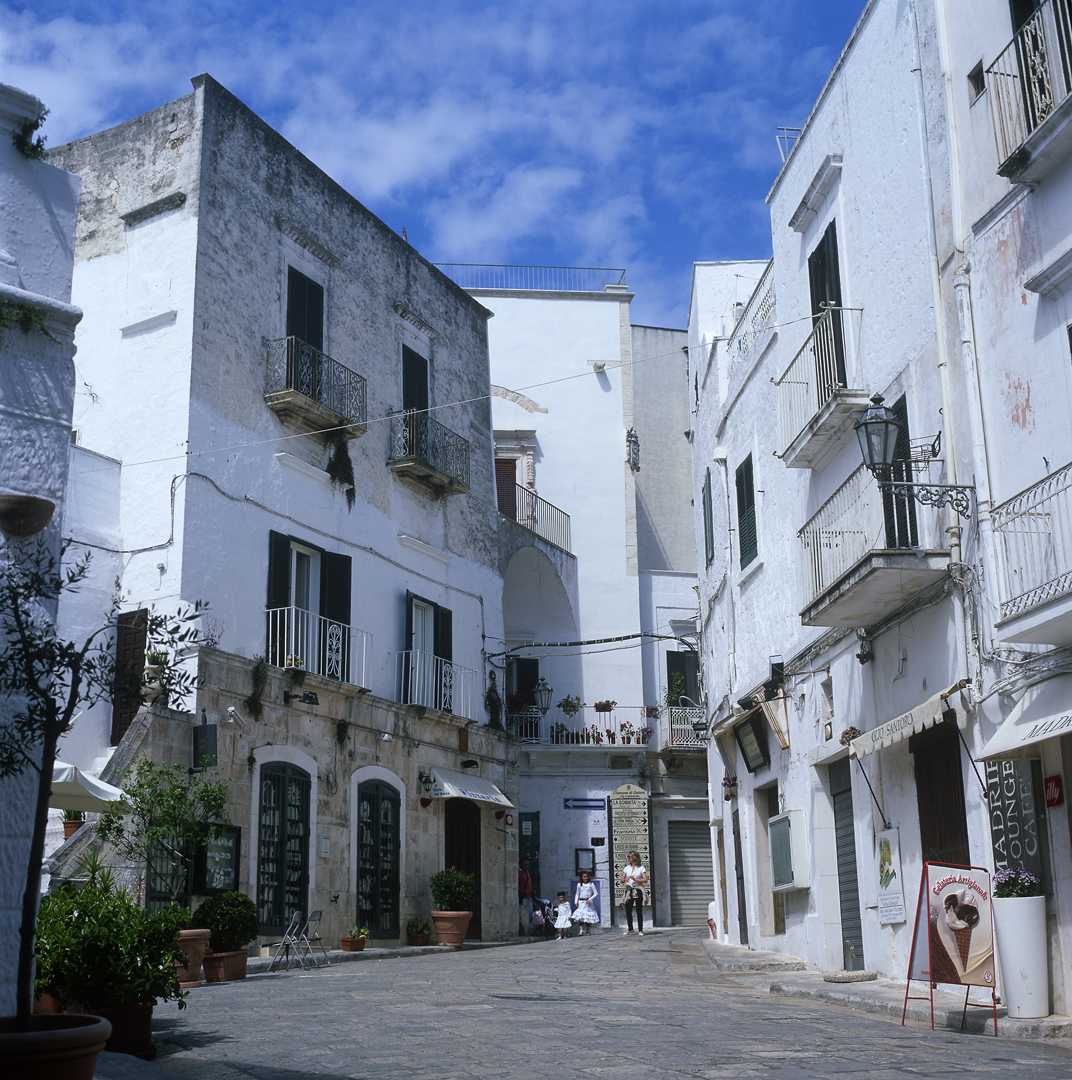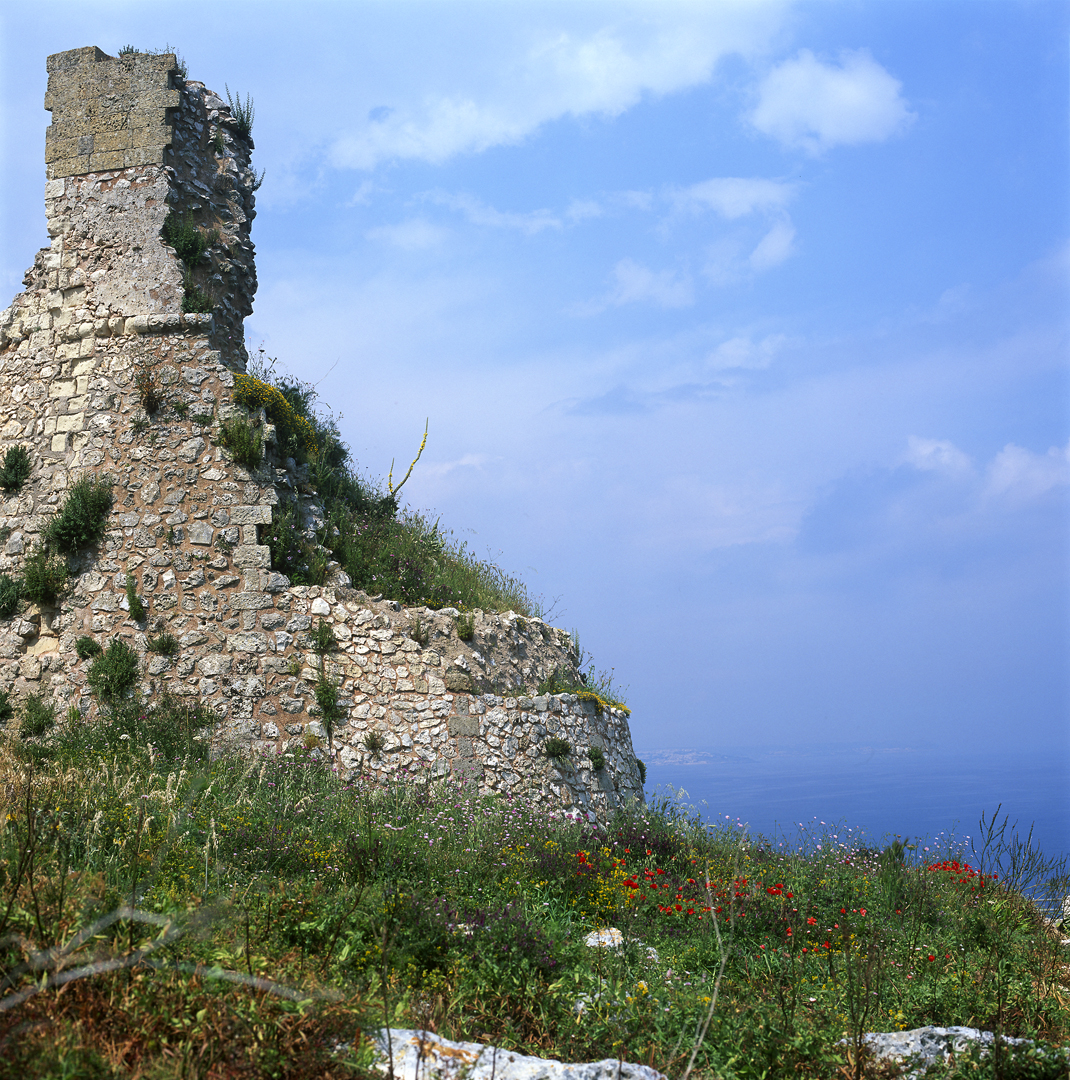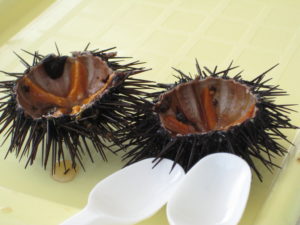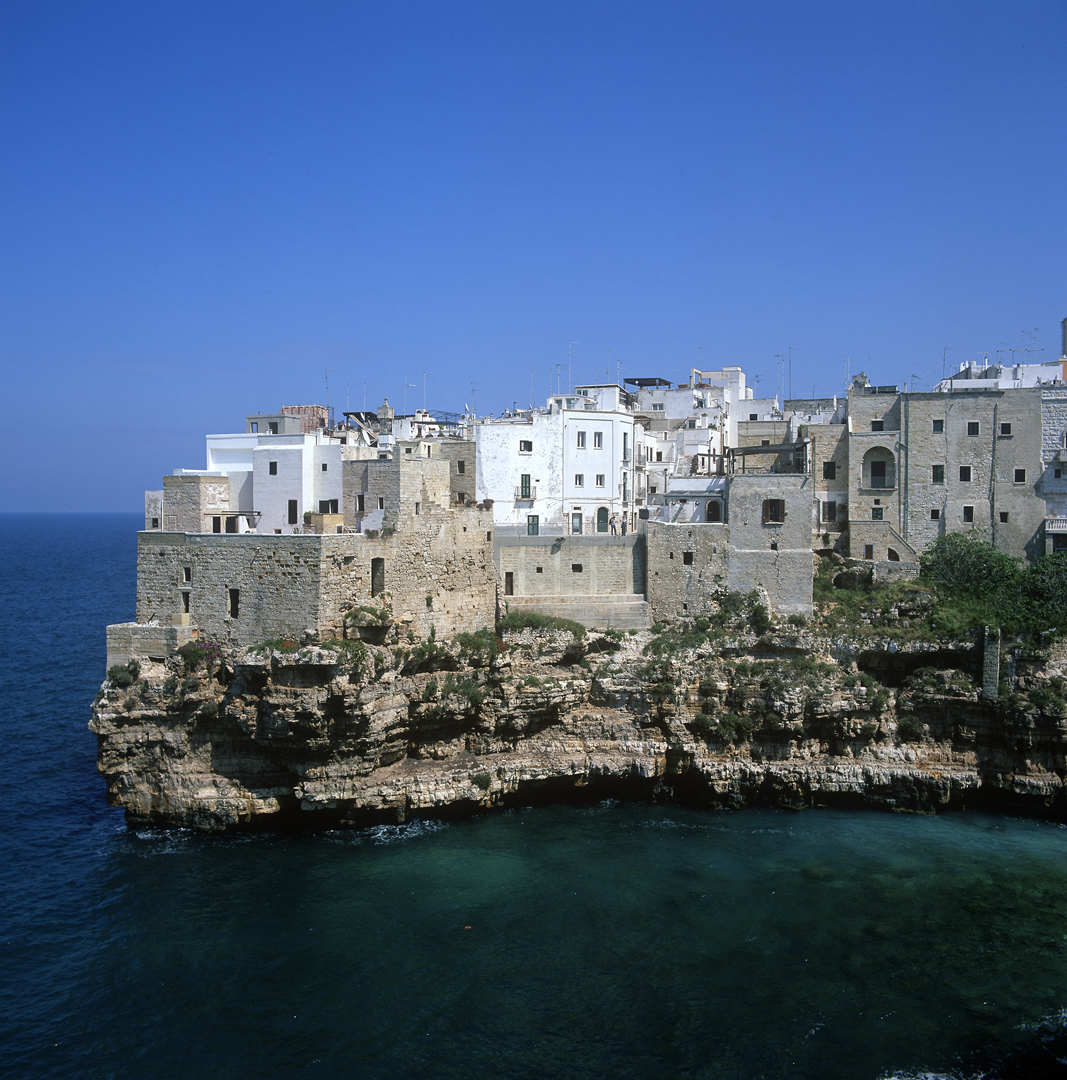Puglia feels different: the terrain, the climate and the culture. The Apennines sweep down the entire length of peninsular Italy but when they get to the bottom they turn west and run down to the “toe”. Puglia, on the Salento peninsula – the “heel”- is bypassed by the mountains and is comparatively flat. I read somewhere that geologically Puglia is not really part of Italy but is joined to Albania, which isn’t far away – you can see it on the other side of the Adriatic on a clear day. Puglia is very fertile – at least it is now. The climate is hot and dry, but a large-scale irrigation scheme in the Fascist era brought water down from the mountains in Abruzzo and agriculture was transformed. That being said, some of the very ancient olive trees you see in Puglia clearly pre-date the coming of irrigation by hundreds of years.
Sadly, these olive trees are currently threatened by the Xylella fastidiosa bacterium, although there have been reports that some varieties may be resistant to the infection.
To my Australian tastes the intensely-flavoured red wines of the region made from grape varieties such as Negroamaro, Primitivo and Aglianico are very good, and excellent value.
In the last ten years or so Puglia has been well and truly discovered by northern Europeans and especially Brits, assisted by direct flights into Bari. This has driven property prices up and earned it the ironic name “Salentoshire” (cf. the “Chiantishire” of twenty years ago).
The towns look like nowhere else in Italy: either white-painted and looking like they belong in the Aegean or North Africa, or in the larger towns, with buildings made of the most fantastically-carved sandstone. In a small area around the town of Alberobello you also get the famous cone-shaped huts called trulli.
We visited Alberobello to see the trulli – not to do so would be like visiting Pisa and skipping the leaning tower – but it was a very touristy experience with many of the trulli on the main street having been converted to souvenir shops selling snowdomes and fridge magnets. By ducking into a doorway we just avoided being accidental extras in a Japanese TV travel show. The best place to see trulli is out in the countryside, where a reasonable number still survive.

We were staying in the town of Ostuni. Its Greek origins are clear from the name: it is from Αστυνέον or “new city”– Latinised as “Astynéon” (at some point the stress moved to the first syllable in Italian). It has to be one of the classic Pugliese views – a snow-white town sitting on its hill a few kilometres from the coast, with the coastal plain beneath it covered with olive groves and dotted with masserie all the way to the horizon.

To be in the centre of Ostuni is a delight – little winding streets in among all the white houses, leading up to a gorgeously-carved duomo at the top of the hill. Nearby were a caseificio from which we could buy fresh burrata and mozzarella, and a bakery. We were there on Easter Sunday and after mass the families came out with their children dressed in white and took them to buy gelato as a reward for being good during the service.

It is quite common to find reputable travel guides and online publications ascribing the “Greek look” to the fact that this region was settled by the Greeks in antiquity, and formed part of Magna Graecia. With all respect, this sounds like rubbish to me. Partly because it was a very long time ago indeed (starting from the 8th Century BC in fact) and other parts of Magna Graecia like Sicily and Naples do not show any such influence. Secondly because if there were to have been a period of Greek influence, it is far more likely to have been when this area was last under Byzantine rule in the 9th-11th centuries AD – much more recently. But it could also be a matter of simple proximity to Greece.


So what is the history of Puglia like? Complicated, is the answer. The Greek colonists arrived in the 8th Century BC, fought fiercely with each other, but largely co-existed with the pre-existing Messapian people. In 216 BC Apulia, as it was then called, was the location of the second catastrophic Roman defeat by Hannibal at the Battle of Cannae. The city-states of Apulia were gradually absorbed into the Roman state, particularly after the so-called “Social Wars” of around 90 BC.
After the fall of the Western Empire, Apulia was overrun by the Goths, then reconquered by the Byzantines, conquered by the Lombards, ravaged by the Saracens, reconquered by the Byzantines again, then taken, in the 11th Century, by our old friend the Norman adventurer Robert “Guiscard” de Hauteville from whom it passed to his nephew Roger as part of a unified “Kingdom of Sicily”. You can read more about Robert and his family in my post on Norman Sicily.
After the extinction of the male line of the Hauteville dynasty, the kingdom passed through Constance de Hauteville to the Hohenstaufen Holy Roman Emperors in the person of Constance’s son, the polymath Frederick the Second (Stupor Mundi, the wonder of the world). For Frederick, Apulia seems not to have been just a part, but the heart, of his domains. Although he grew up in Sicily and spent his early manhood in Germany, he publicly announced his choice of Apulia as his favourite place to live. Praise for one’s home region or province or town is the way to the Italian heart and so the Pugliese have returned the compliment and to this day regard him as very much one of their own.
After the Hohenstaufens came the Angevins from France and then the Aragonese from Spain, and the realm became known as the Kingdom of Naples. In due course the kingdom was inherited by a minor branch of the Bourbons in whose hands, apart from a couple of interruptions caused by Napoleon, the kingdom remained until Garibaldi’s astonishing campaign delivered it to the House of Savoy and it became part of united Italy in 1861. The later stages of Bourbon rule got quite a bad press in the rest of Europe. Some of it was deserved, as occasional experiments in liberalisation were regularly followed by periods of drastic conservative overreaction and oppression. Banditry was rife. Some of it was less deserved, as the cause of Italian unity had been embraced by liberal thinking, especially in Britain, and all such stories need their villains.
I intend to write further on this period but it will have to wait for another visit to Naples after which I will have some more photographs to go with it.
To the legacies of all these dominant cultures must be added the effects of external forces. Saracen raids over centuries led to the construction of coastal watch towers, and rural populations tended to group together in fortified farmsteads called masserie. Both add a characteristic look to the landscape (these days, many masserie have been renovated as agriturismi and resort accommodation).

As the Ottoman Empire advanced through Greece and the Balkans in the 15th and 16th Centuries, some groups of Greek and Albanian refugees emigrated to Puglia and lived in villages where forms of Greek and Albanian were spoken until very recently.
As in Sicily, the main architectural legacy of the Normans is in the form of massive Romanesque cathedrals, such as that in Bari. Frederick II left many castles, the most famous being the celebrated octagonal “Castel del Monte”. Later, under Bourbon rule, the exuberant carved decoration on buildings in towns like Lecce added a unique local flavour to the baroque style.

Altogether the effect, as in Sicily, is of the sort of layer-cake of cultures that causes the classier sort of travel writer (ahem) to use the word “palimpsest”.
For English-speakers, one of the other famous castles in Puglia is the one in Otranto – rather by accident, it turns out. In 1786 Horace Walpole created the “gothic” literary genre with his novel The Castle of Otranto, a Gothic Story. However Walpole had never been there, and picked the name from a map because he liked the sound of it (ensuring that generations of English speakers have mispronounced the name: as with Ostuni, the accent is on the first syllable). Walpole later admitted that at the time he didn’t even know whether the town possessed a castle. It does, and there are some excellent views from the battlements.

Also worth a visit is the cathedral which has an extraordinary early-medieval mosaic floor showing a “tree of life”, which in addition to depicting the conventional bible stories, shows various endearing mythological creatures and references to the story of King Arthur. The cathedral also contains a grim memorial containing real human skulls – in 1480 the town was taken by the Ottomans as the first step in a campaign intended to conquer Rome. Around 800 people were decapitated after refusing conversion to Islam. The Ottomans held the town for a couple of years before abandoning the campaign.

Otranto is quite close to the bottom of the Salentine Peninsula and it was a short but very pleasant drive down the coast along clifftops covered in spring flowers to the Cape of Santa Maria di Leuca. On the way we passed a good many watchtowers, in varying stages of disrepair.

South of Otranto we stopped for lunch in a small place called Porto Badisco. There we found a little trattoria serving fresh sea urchins (“ricci”), a speciality of the season. You don’t actually eat the flesh of the sea-urchins – someone cuts them in half with shears and throws away the flesh. That just leaves the roe, which you scoop out with a plastic spoon. It tastes of the sea. Lou then had spaghetti with a ricci sauce and I had Polipo in Pignata, which is octopus in a tomato, potato, garlic and chili sauce. It was one of the most enjoyable meals we have eaten in Italy (not to mention one of the cheapest).




Another characteristically pretty Pugliese town is Polignano a Mare. It sits on the edge of a low cliff over the Adriatic, and needless to say the seafood is excellent. We ate in a restaurant where the proprietor turned out to have fond memories of some years spent in Melbourne.


Not surprisingly, Polignano has been used as a location for a few films and TV series. Also not surprisingly, it has real estate agents whose window displays are in English, which gives you an indication of the prices.

